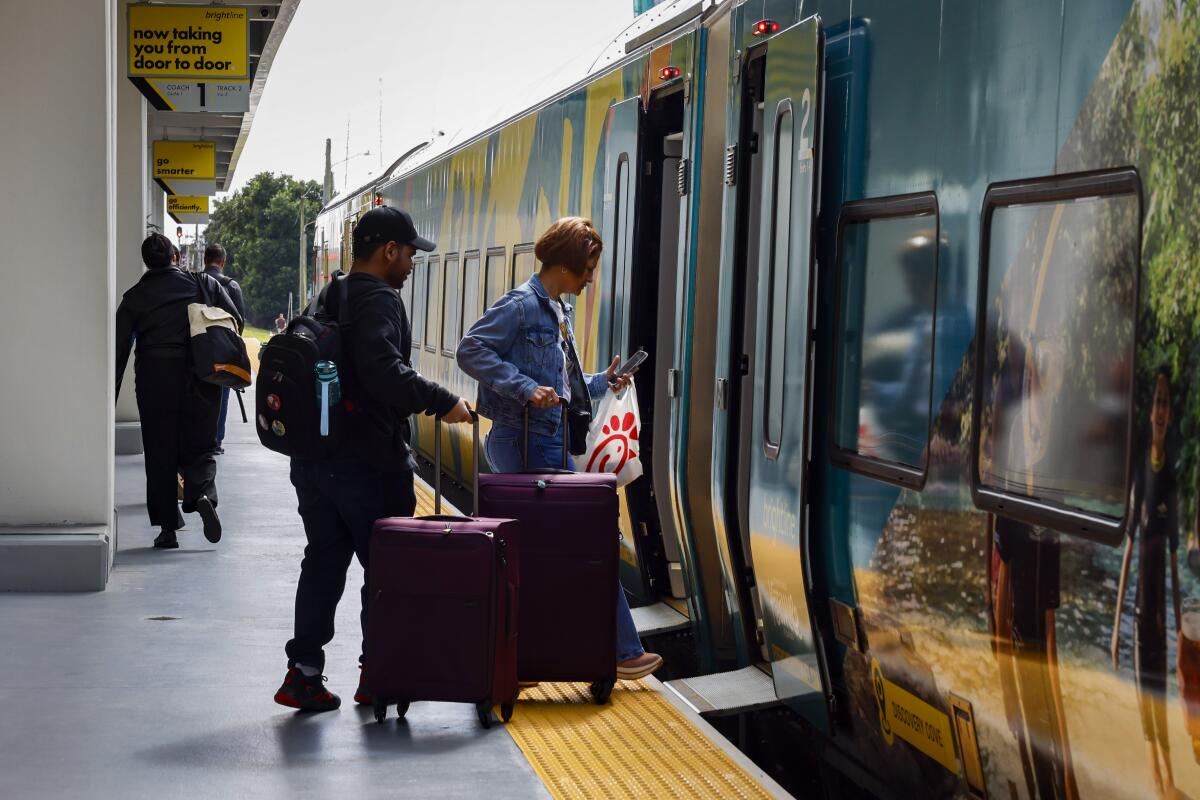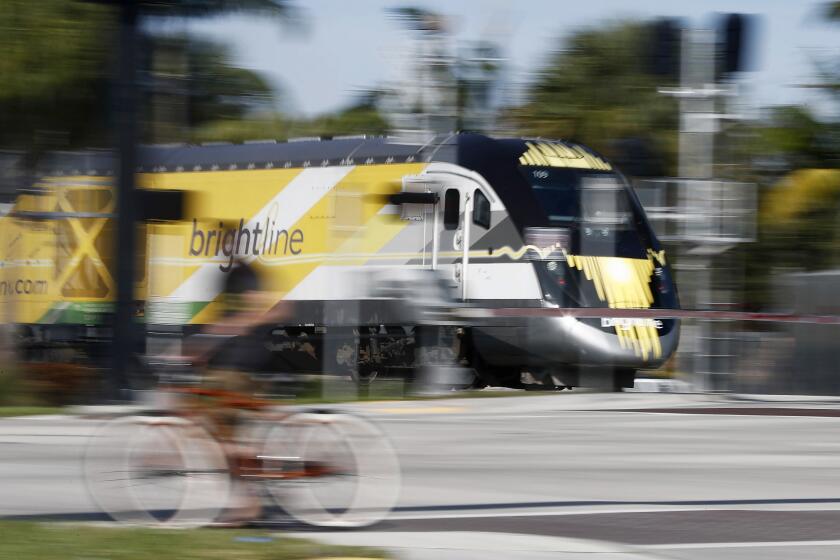High-speed rail to Las Vegas is coming as soon as 2028. Here are more details

- Share via
Southern Californians can expect to board a high-speed train as soon as 2028 for a two-hour ride to Las Vegas, officials on the $12-billion project said when construction ceremonially broke ground Monday in Sin City.
“We’ll move millions of people between two of the most exciting and important regions of the country, Southern California and here in southern Nevada,” said Wes Edens, Brightline’s founder and chairman and a private equity billionaire. “We are the only industrialized country in the world that doesn’t have a high-speed rail in America, and four years from now, we won’t be saying that anymore.”
At the soon-to-be site of Brightline’s train depot in Las Vegas, U.S. Transportation Secretary Pete Buttigieg joined Nevada Gov. Joe Lombardo and Brightline executives to tout the 218-mile federally subsidized electric rail system. Backers of the line say it will help reduce pollution along often congested Interstate 15, which runs between the two regions.
“I really view this as the beginning of the high-speed rail era in the United States of America,” Buttigieg said.
The project, whose construction launched on Earth Day, is expected to cut 800 million pounds of carbon pollution a year once completed, Buttigieg said.
Brightline, a private company that operates an intercity rail line connecting Miami and Orlando, Fla., hopes to be the first to run a private high-speed service in the U.S.
Bullet train project connecting Inland Empire and Las Vegas scores a $3-billion award. Brightline West would be the fastest high-speed rail to operate in the U.S.
Its proposed railway has rapidly gone from blueprints to construction, unlike California’s high-speed line between Los Angeles and the Bay Area, whose progress has been slowed to a crawl by political disputes, cost overruns and permit delays.
To get the L.A.-to-Vegas idea off the ground, the federal government awarded Brightline West $3 billion from the 2021 Infrastructure Investment and Jobs Act , which authorized up to $102 billion for rail improvements. The rest of the project will be privately funded, although taxpayers are contributing there as well; the Biden administration has enabled the project to borrow $3.5 billion through tax-exempt bonds.
The rail line will run within the highway median and support speeds of up to 200 mph. Upon completion, it will include 322 miles of overhead electrical lines to power the trains.
Even though ticket sales are four years away, here’s what we already know about possible ticket prices and stops along the route.
How much will tickets cost?
Brightline hasn’t announced ticket prices yet or even given a range of possible charges. With the project headed into four years of construction, Edens said, the company is “hardly ready to set prices right now.”
But Edens noted that ticket charges on other high-speed rail lines average 50 cents to $1 per mile, while Amtrak’s express service from New York to Washington costs about $1.25 a mile.
Edens previously told The Times that he’s looking at those amounts as possible charges on this line, which would put the cost at more than $400 for a round trip from Rancho Cucamonga to Las Vegas.
But he noted on Monday that to stay competitive with airfare and driving, the price would probably go up and down, depending on demand, seasons and other factors.
Where will the stations be?
Southern Californians can catch a ride on the high-speed train at stations in Rancho Cucamonga, Hesperia, Victor Valley and Las Vegas.
About four miles north of Ontario International Airport, the Rancho Cucamonga station will sit on a five-acre property at the northwest corner of Milliken Avenue and Azusa Court in San Bernardo County. This station will be co-located with California Metrolink trains to and from downtown Los Angeles and other locations in Los Angeles, Orange, San Bernardino and Riverside counties.
The Hesperia station will be at the 15 Freeway and Joshua Street interchange. This station also will host local rail service for residents in the high desert on select weekday trains.
In Apple Valley, the Victor Valley station will be on a 300-acre parcel southeast of Dale Evans Parkway and the 15 Freeway interchange. This station is intended to offer a future connection to the multimodal High Desert Corridor and the California High Speed Rail line.
Las Vegas’ station will be situated on the Las Vegas Strip, north of Blue Diamond Road between the 15 Freeway and Las Vegas Boulevard. This station will give riders access to the Harry Reid International Airport, the Las Vegas Convention Center and the NFL Raiders’ Allegiant Stadium through local transit services.
All four stations are slated to have parking. Those in Rancho Cucamonga and Las Vegas will have approximately 80,000 square feet of parking, and Victor Valley is expected to have 20,000 square feet. No details were available Monday about the parking planned for the Hesperia station.
More to Read
Sign up for Essential California
The most important California stories and recommendations in your inbox every morning.
You may occasionally receive promotional content from the Los Angeles Times.













